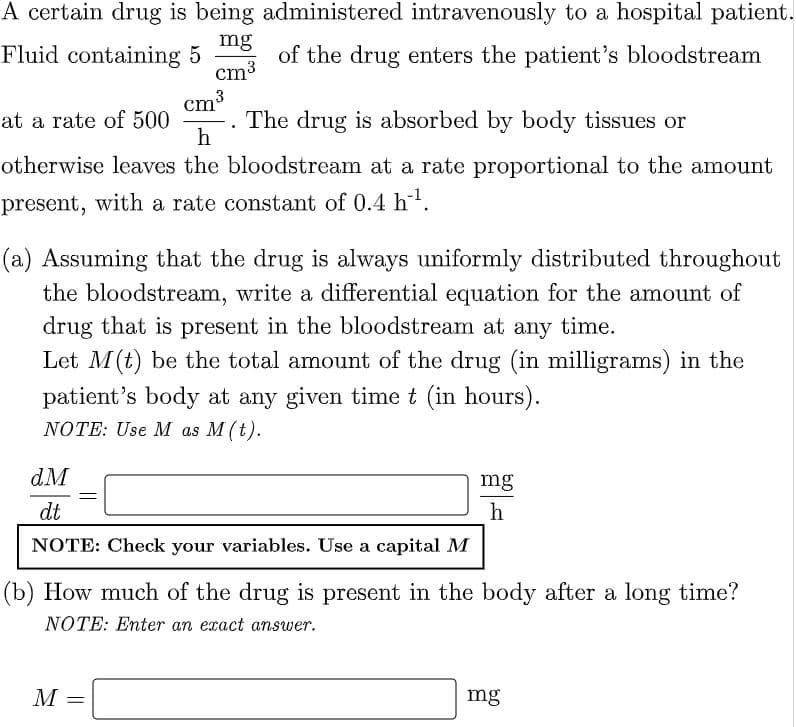A certain drug is being administered intravenously to a hospital patient. mg Fluid containing 5 cm3 of the drug enters the patient's bloodstream cm3 at a rate of 500 The drug is absorbed by body tissues or h otherwise leaves the bloodstream at a rate proportional to the amount present, with a rate constant of 0.4 h. (a) Assuming that the drug is always uniformly distributed throughout the bloodstream, write a differential equation for the amount of drug that is present in the bloodstream at any time. Let M(t) be the total amount of the drug (in milligrams) in the patient's body at any given time t (in hours). NOTE: Use M as M (t). dM mg dt h NOTE: Check your variables. Use a capital M (b) How much of the drug is present in the body after a long time? NOTE: Enter an exact answer.
A certain drug is being administered intravenously to a hospital patient. mg Fluid containing 5 cm3 of the drug enters the patient's bloodstream cm3 at a rate of 500 The drug is absorbed by body tissues or h otherwise leaves the bloodstream at a rate proportional to the amount present, with a rate constant of 0.4 h. (a) Assuming that the drug is always uniformly distributed throughout the bloodstream, write a differential equation for the amount of drug that is present in the bloodstream at any time. Let M(t) be the total amount of the drug (in milligrams) in the patient's body at any given time t (in hours). NOTE: Use M as M (t). dM mg dt h NOTE: Check your variables. Use a capital M (b) How much of the drug is present in the body after a long time? NOTE: Enter an exact answer.
Calculus: Early Transcendentals
8th Edition
ISBN:9781285741550
Author:James Stewart
Publisher:James Stewart
Chapter1: Functions And Models
Section: Chapter Questions
Problem 1RCC: (a) What is a function? What are its domain and range? (b) What is the graph of a function? (c) How...
Related questions
Question

Transcribed Image Text:A certain drug is being administered intravenously to a hospital patient.
Fluid containing 5
mg
of the drug enters the patient's bloodstream
cm3
cm3
The drug is absorbed by body tissues or
h
at a rate of 500
otherwise leaves the bloodstream at a rate proportional to the amount
present, with a rate constant of 0.4 hl.
(a) Assuming that the drug is always uniformly distributed throughout
the bloodstream, write a differential equation for the amount of
drug that is present in the bloodstream at any time.
Let M(t) be the total amount of the drug (in milligrams) in the
patient's body at any given time t (in hours).
NOTE: Use M as M(t).
dM
mg
dt
h
NOTE: Check your variables. Use a capital M
(b) How much of the drug is present in the body after a long time?
NOTE: Enter an exact answer.
M
mg
Expert Solution
This question has been solved!
Explore an expertly crafted, step-by-step solution for a thorough understanding of key concepts.
This is a popular solution!
Trending now
This is a popular solution!
Step by step
Solved in 2 steps with 2 images

Recommended textbooks for you

Calculus: Early Transcendentals
Calculus
ISBN:
9781285741550
Author:
James Stewart
Publisher:
Cengage Learning

Thomas' Calculus (14th Edition)
Calculus
ISBN:
9780134438986
Author:
Joel R. Hass, Christopher E. Heil, Maurice D. Weir
Publisher:
PEARSON

Calculus: Early Transcendentals (3rd Edition)
Calculus
ISBN:
9780134763644
Author:
William L. Briggs, Lyle Cochran, Bernard Gillett, Eric Schulz
Publisher:
PEARSON

Calculus: Early Transcendentals
Calculus
ISBN:
9781285741550
Author:
James Stewart
Publisher:
Cengage Learning

Thomas' Calculus (14th Edition)
Calculus
ISBN:
9780134438986
Author:
Joel R. Hass, Christopher E. Heil, Maurice D. Weir
Publisher:
PEARSON

Calculus: Early Transcendentals (3rd Edition)
Calculus
ISBN:
9780134763644
Author:
William L. Briggs, Lyle Cochran, Bernard Gillett, Eric Schulz
Publisher:
PEARSON

Calculus: Early Transcendentals
Calculus
ISBN:
9781319050740
Author:
Jon Rogawski, Colin Adams, Robert Franzosa
Publisher:
W. H. Freeman


Calculus: Early Transcendental Functions
Calculus
ISBN:
9781337552516
Author:
Ron Larson, Bruce H. Edwards
Publisher:
Cengage Learning